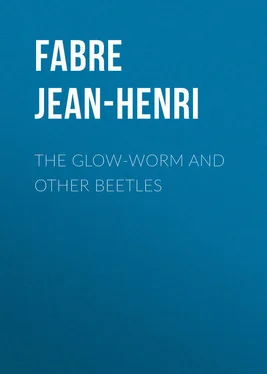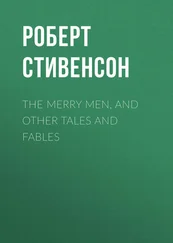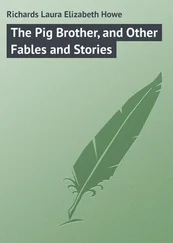Jean-Henri Fabre - The Glow-Worm and Other Beetles
Здесь есть возможность читать онлайн «Jean-Henri Fabre - The Glow-Worm and Other Beetles» — ознакомительный отрывок электронной книги совершенно бесплатно, а после прочтения отрывка купить полную версию. В некоторых случаях можно слушать аудио, скачать через торрент в формате fb2 и присутствует краткое содержание. Жанр: foreign_antique, foreign_prose, на английском языке. Описание произведения, (предисловие) а так же отзывы посетителей доступны на портале библиотеки ЛибКат.
- Название:The Glow-Worm and Other Beetles
- Автор:
- Жанр:
- Год:неизвестен
- ISBN:нет данных
- Рейтинг книги:5 / 5. Голосов: 1
-
Избранное:Добавить в избранное
- Отзывы:
-
Ваша оценка:
- 100
- 1
- 2
- 3
- 4
- 5
The Glow-Worm and Other Beetles: краткое содержание, описание и аннотация
Предлагаем к чтению аннотацию, описание, краткое содержание или предисловие (зависит от того, что написал сам автор книги «The Glow-Worm and Other Beetles»). Если вы не нашли необходимую информацию о книге — напишите в комментариях, мы постараемся отыскать её.
The Glow-Worm and Other Beetles — читать онлайн ознакомительный отрывок
Ниже представлен текст книги, разбитый по страницам. Система сохранения места последней прочитанной страницы, позволяет с удобством читать онлайн бесплатно книгу «The Glow-Worm and Other Beetles», без необходимости каждый раз заново искать на чём Вы остановились. Поставьте закладку, и сможете в любой момент перейти на страницу, на которой закончили чтение.
Интервал:
Закладка:
This is how things happen: a Snail has been rendered insensible by the Glow-worm. The operator is nearly always alone, even when the prize is a large one, like the Common Snail, Helix aspersa . Soon a number of guests hasten up – two, three or more – and, without any quarrel with real proprietor, all alike fall to. Let us leave them to themselves for a couple of days and then turn the shell, with the opening downwards. The contents flow out as easily as would soup from an overturned saucepan. When the sated diners retire from this gruel, only insignificant leavings remain.
The matter is obvious: by repeated tiny bites, similar to the tweaks which we saw distributed at the outset, the flesh of the mollusc is converted into a gruel on which the various banqueters nourish themselves without distinction, each working at the broth by means of some special pepsine and each taking his own mouthfuls of it. In consequence of this method, which first converts the food into a liquid, the Glow-worm's mouth must be very feebly armed apart from the two fangs which sting the patient and inject the anæsthetic poison and, at the same time, no doubt, the serum capable of turning the solid flesh into fluid. These two tiny implements, which can just be examined through the lens, must, it seems, have some other object. They are hollow and in this resemble those of the Ant-lion, which sucks and drains its capture without having to divide it; but there is this great difference, that the Ant-lion leaves copious remnants, which are afterwards flung outside the funnel-shaped trap dug in the sand, whereas the Glow-worm, that expert liquefier, leaves nothing, or next to nothing. With similar tools, the one simply sucks the blood of its prey and the other turns every morsel of his to account, thanks to a preliminary liquefaction.
And this is done with exquisite precision, though the equilibrium is sometimes anything but steady. My rearing-glasses supply me with magnificent examples. Crawling up the sides, the Snails imprisoned in my apparatus sometimes reach the top, which is closed with a glass pane, and fix themselves to it by means of a speck of glair. This is a mere temporary halt, in which the mollusc is miserly with its adhesive product, and the merest shake is enough to loosen the shell and send it to the bottom of the jar.
Now it is not unusual for the Glow-worm to hoist himself to the top, with the help of a certain climbing-organ that makes up for his weak legs. He selects his quarry, makes a minute inspection of it to find an entrance-slit, nibbles it a little, renders it insensible and, without delay, proceeds to prepare the gruel which he will consume for days on end.
When he leaves the table, the shell is found to be absolutely empty; and yet this shell, which was fixed to the glass by a very faint stickiness, has not come loose, has not even shifted its position in the smallest degree: without any protest from the hermit gradually converted into broth, it has been drained on the very spot at which the first attack was delivered. These small details tell us how promptly the anæsthetic bite takes effect; they teach us how dexterously the Glow-worm treats his Snail without causing him to fall from a very slippery vertical support and without even shaking him on his slight line of adhesion.
Under these conditions of equilibrium, the operator's short, clumsy legs are obviously not enough; a special accessory apparatus is needed to defy the danger of slipping and to seize the unseizable. And this apparatus the Lampyris possesses. At the hinder end of the animal we see a white spot which the lens separates into some dozen short, fleshy appendages, sometimes gathered into a cluster, sometimes spread into a rosette. There is your organ of adhesion and locomotion. If he would fix himself somewhere, even on a very smooth surface, such as a grass-stalk, the Glow-worm opens his rosette and spreads it wide on the support, to which it adheres by its own stickiness. The same organ, rising and falling, opening and closing, does much to assist the act of progression. In short, the Glow-worm is a new sort of self-propelled cripple, who decks his hind-quarters with a dainty white rose, a kind of hand with twelve fingers, not jointed, but moving in every direction: tubular fingers which do not seize, but stick.
The same organ serves another purpose: that of a toilet-sponge and brush. At a moment of rest, after a meal, the Glow-worm passes and repasses the said brush over his head, back, sides and hinder-parts, a performance made possible by the flexibility of his spine. This is done point by point, from one end of the body to the other, with a scrupulous persistency that proves the great interest which he takes in the operation. What is his object in thus sponging himself, in dusting and polishing himself so carefully? It is a question, apparently, of removing a few atoms of dust or else some traces of viscidity that remain from the evil contact with the snail. A wash and brush-up is not superfluous when one leaves the tub in which the mollusc has been treated.
If the Glow-worm possessed no other talent than that of chloroforming his prey by means of a few tweaks resembling kisses, he would be unknown to the vulgar herd; but he also knows how to light himself like a beacon; he shines, which is an excellent manner of achieving fame. Let us consider more particularly the female, who, while retaining her larval shape, becomes marriageable and glows at her best during the hottest part of summer. The lighting-apparatus occupies the last three segments of the abdomen. On each of the first two, it takes the form, on the ventral surface, of a wide belt covering almost the whole of the arch; on the third, the luminous part is much less and consists simply of two small crescent-shaped markings, or rather two spots which shine through to the back and are visible both above and below the animal. Belts and spots emit a glorious white light, delicately tinged with blue. The general lighting of the Glow-worm thus comprises two groups: first, the wide belts of the two segments preceding the last; secondly, the two spots of the final segments. The two belts, the exclusive attribute of the marriageable female, are the part richest in light: to glorify her wedding, the future mother dons her brightest gauds; she lights her two resplendent scarves. But, before that, from the time of the hatching, she had only the modest rush-light of the stern. This efflorescence of light is the equivalent of the final metamorphosis, which is usually represented by the gift of wings and flight. Its brilliance heralds the pairing-time. Wings and flight there will be none: the female retains her humble larval form, but she kindles her blazing beacon.
The male, on his side, is fully transformed, changes his shape, acquires wings and wing-cases; nevertheless, like the female, he possesses, from the time when he is hatched, the pale lamp of the end segment. This luminous aspect of the stern is characteristic of the entire Glow-worm tribe, independently of sex and season. It appears upon the budding grub and continues throughout life unchanged. And we must not forget to add that it is visible on the dorsal as well as on the ventral surface, whereas the two large belts peculiar to the female shine only under the abdomen.
My hand is not so steady nor my sight so good as once they were, but, as far as they allow me, I consult anatomy for the structure of the luminous organs. I take a scrap of the epidermis and manage to separate pretty neatly half of one of the shining belts. I place my preparation under the microscope. On the skin, a sort of white-wash lies spread, formed of a very fine, granular substance. This is certainly the light-producing matter. To examine this white layer more closely is beyond the power of my weary eyes. Just beside it is a curious air-tube, whose short and remarkably wide stem branches suddenly into a sort of bushy tuft of very delicate ramifications. These creep over the luminous sheet, or even dip into it. That is all.
Читать дальшеИнтервал:
Закладка:
Похожие книги на «The Glow-Worm and Other Beetles»
Представляем Вашему вниманию похожие книги на «The Glow-Worm and Other Beetles» списком для выбора. Мы отобрали схожую по названию и смыслу литературу в надежде предоставить читателям больше вариантов отыскать новые, интересные, ещё непрочитанные произведения.
Обсуждение, отзывы о книге «The Glow-Worm and Other Beetles» и просто собственные мнения читателей. Оставьте ваши комментарии, напишите, что Вы думаете о произведении, его смысле или главных героях. Укажите что конкретно понравилось, а что нет, и почему Вы так считаете.












